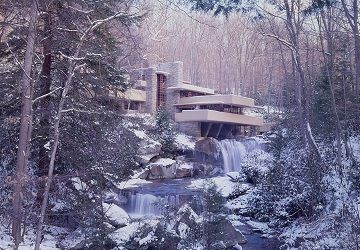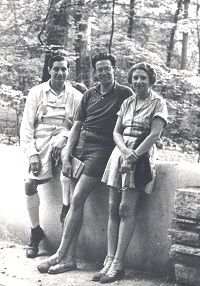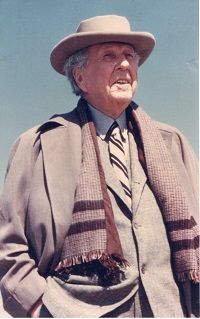Frank Lloyd Wright's Fallingwater Offers an Architectural 'Symphony'
"This is a symphony, said the Atlanta architect John Portman when he led colleagues on a 2012 visit to Fallingwater. "This whole thing is a symphony. It's like music. You've got note after note after note. You've got high points and low. It's marvelous. It's all been choreographed."

Image Source: Robert P. Ruschak/Courtesy of the Western Pennsylvania Conservancy
Visitors’ feet patter down the wooded paths. Then, as they round a curve, the house emerges through the trees. There it is: Frank Lloyd Wright’s Fallingwater.
With 3 cantilevered terraces built over Bear Run Creek, Fallingwater presents a unique blend of form, function, and nature. The American Association of Architects once named Fallingwater the most important building of the 20th Century, and it has been nominated to become a UNESCO World Heritage site.
Since it opened to the public in 1964, Fallingwater has welcomed more than 3.4 million visitors from all over the world. They’ve included people ranging from bucket list pilgrims to celebrities such as Einstein, Steve Jobs, and actor Brad Pitt, whose wife Angelina Jolie arranged a private tour for him as a 43rd birthday present.
Related: Resorts to Light Up the Season
This National Historic landmark that Wright constructed in the late 1930s for a Pittsburgh millionaire remains ever modern. It’s about water and light, sound and natural surroundings, the outdoors coming indoors, and the inside moving outside. Experts explain that part of the genius of Wright’s design was orienting the building site so that the view from the house is not looking at the creek’s waterfall. Rather he created an experience of being in it.
"There in a beautiful forest was a solid, high rock ledge rising beside a waterfall, and the natural thing seemed to cantilever the house from that rock bank over the falling water," Wright explained in a 1952 television interview. "Then came of course Mr. [E.J.] Kaufmann's love for the beautiful site. He loved the site where the house was built and liked to listen to the waterfall. So that was the prime motive for the design. ... I think you can hear the waterfall when you look at the design. At least it is there, and he lives intimately with the thing he loves."

Kaufmann was a department store magnet who had accumulated more 1,900 acres at Bear Run in a southwestern Pennsylvania area known as the Laurel Highlands. Wright designed the house to be built from stone quarried nearby, wood, cement, and metal which is painted in his signature Cherokee Red. The cantilevers which support surrounding terraces are a natural biscuit color.
The great room on the entry floor has "ribbons of windows" designed to melt away the corners. Wright played with scale to slightly lower the ceiling so that as someone enters this living room he is inclined to look up and out the windows. The slight drop in the ceilings of the bedrooms on the floor above induce the feeling of being ready to lie down.
From Left: Edgar Kaufman, Senior, Edgar Kaufman, Junior, Liliane Kaufmann; Image Source: Courtesy of the Western Pennsylvania Conservancy

Part of Wright's genius was his attention to detail. The living room floor is made from polished sandstone scored to look like river rock. Bedside lights in the bedroom appeared to be bronze-colored metal shaped like slim ledgers, but when they are turned around and clicked on they illuminate enough space for reading.
"This is a symphony,” said the Atlanta architect John Portman when he led colleagues on a 2012 visit to Falling Water. "This whole thing is a symphony. It's like music. You've got note after note after note. You've got high points and low. It's marvelous. It's all been choreographed."
Although Fallingwater has been gorgeously revealed in photographs and film, there is no substitute for personally being in the experience of its beauty. There are many ways to visit Falling Water, which has been preserved by the Western Pennsylvania Conservancy. The site is about 90 minutes south of Pittsburgh.
Frank Lloyd Wright; Image Source: Courtesy of the Western Pennsylvania Conservancy
Guided tours: Options include the 1-hour guided tour where small groups of about 14 people move through the house in a way that preceding groups are on to the next space before the next group enters. These visits are most appropriate for adults. Children under 6 not permitted on the group house tours and children under 9 are not allowed on the special tours.
Architecture buffs can take advantage of a 2-hour tour where guides provide a more technical narrative. Sunset tours show off the glory of the surroundings.
Grounds Pass: Those who prefer to observe Falling Water from the outside can obtain grounds passes that allow self-guided grounds to view of the exterior of the house only.
Life-long learning adventures: Three-day intensives called Insight/Onsite are scheduled for May and September in 2017. A group of 12 participants gather for meals, discussions, lectures and walks, and privately explore the house. Accommodations are provided on the grounds.
Armchair Traveler: The "Explore" section on the Fallingwater website provides a feast of videos and slide shows that show off the house, illustrate its history and construction, catalog some of its furnishings and artworks, and tell more about Wright and the Kaufmanns, who were cultural and civic leaders in Pittsburgh. Additional architectural insights about Fallingwater and views of the house can be found in videos online such as and Noy Washington's documentary and a video of Portman's visit.
Fallingwater is a home for all seasons and it is open to visitors from March through December on every day except Wednesdays. Advanced planning is a key to enjoying a visit. December can be a good time to go given the lesser demand for reservations that fill up quickly in the summer. Reservations can be made online at fallingwater.org.
ACTIVA BioACTIVE Bulk Flow Marks Pulpdent’s First Major Product Release in 4 Years
December 12th 2024Next-generation bulk-fill dental restorative raises the standard of care for bulk-fill procedures by providing natural remineralization support, while also overcoming current bulk-fill limitations.